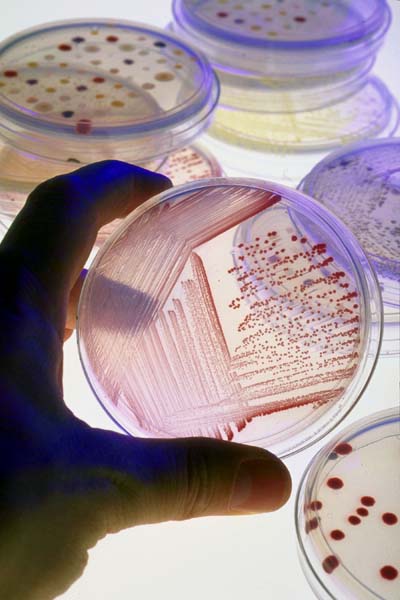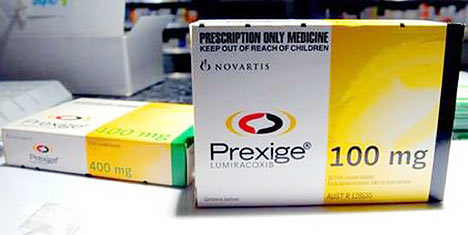- Glycerol-3-phosphate dehydrogenase
- Malic enzyme
- Fatty acyl CoA oxidase
Tag Archives: liver
Scientists create functioning human livers
New York: Researchers have created miniature replicas of human livers which functioned normally in laboratory conditions.
The development may eventually solve the transplant shortage and also remove the need for powerful drugs to prevent the body rejecting the organ. But it will be at least five years before the technology can be used in hospitals.
The project director, Associate Professor Shay Somer of the Wake Forest Institute for Regenerative Medicine in North Carolina said: “We are excited about the possibilities this research represents, but must stress that we’re at an early stage and many technical hurdles must be overcome before it could benefit patients.
“Not only must we learn how to grow billions of liver cells at one time in order to engineer livers large enough for patients, but we must determine whether these organs are safe to use in patients.”
it is estimated that more than a fifth of patients die waiting for a transplant and many livers have to be discarded because they are too old or too damaged to be of any use.
The technology opens up the prospect of growing other replacement organs, including kidneys or pancreases, for patients who are able to donate stem cells.
Pedro Baptista, co-author, said: “Our hope is that once these organs are transplanted, they will maintain and gain function as they continue to develop.”
The new technique works by effectively chemically stripping the old liver down too its basic “scaffold” or exoskeleton in a process of called “decellularisation”.
Onto this frame of connective tissue and blood vessels, they then regrow the new liver using stem cells from the patient.
Laboratory livers that were nourished for a week began growing and functioning like human organs, they said.
Liver disease is the fifth biggest killer in England and Wales, after heart disease, cancer, stroke and respiratory disease, and the only major cause of death that is still increasing year on year.
Some 16,087 people in Britain died from liver disease in 2008, a 4.5 per cent increase on the previous year, and the number of deaths is predicted to double in 20 years.
Sarah Matthews, for the British Liver Trust, said: “Technology such as this is much needed. Currently supply isn’t meeting demand, and for every one person who receives a liver transplant, 10 people die.
 The research was presented at the annual meeting of the American Association for the Study of Liver Diseases in Boston.
The research was presented at the annual meeting of the American Association for the Study of Liver Diseases in Boston.
Coffee is good for women’s hearts

Coffee may protect women against heart disease, a study published in the Annals of Internal Medicine has revealed.
Researched studied 84,000 women from 1980 until 2004 and 42,000 men between 1986 and 2004 and questioned their coffee consumption every four years.
It found that women who drank two or three cups of full-strength coffee a day were 25 per cent less likely to die of heart disease than those who drank none. Those who drank decaffeinated coffe also had lower death rates.
The scientists were unsure why coffee did not confer any benefits on men. The study was also inconclusive on whether it was coffee or some other factor in the women’s lifestyle that was responsible for the positive effect on their health.
Coffee contains antioxidants and tannins which are good for the heart and arteries. It has also been shown to be good for liver and reduce asthma attacks.
Brits overtake Russians in binge drinking league

London: Alcohol consumption in Britain continues to grow with the Brits now drinking more than Russians, according to the latest figures from the World Health Organisation. In addition teenage drinkers in the UK are the drunks of Europe.
WHO figures show that the average Brit drinks 9.29 litres of alcohol each year, compared with 8.87 in Russia.
Luxembourg is in No1 place, followed by the Czech Republic, Estonia and Germany, with the UK 17 and Russia 18 in the league table of drinkers.
The data reveal that in 2003, the latest year for which figures are available, England came top of a European table for drunkenness among 11- and 13-year olds, with twice the levels in Russia.
The increase in drinking is linked the decrease in people setting down to traditional adult responsibilities, such as marriage, say the authors pf a report due to be published in May from the International Center for Alcohol Policies, a Washington-based group.
The study, Swimming with Crocodiles: The Culture of Extreme Drinking, also cites World Health Organisation figures showing that almost twice as many English 15-year-olds as Russians claim to have been drunk more than twice.
In the UK, for example, the number of adults still living with their parents has risen by a fifth among men and almost a third among women in 15 years. About 60% of men and 40% of women aged 20-24 live with their parents.
Fast food harms the liver

Too much fast food and too little exercise can harm the liver in just one month, research suggests.
A small study found that people who ate junk food twice a day experienced varying degrees of damage to their liver.
They also put on large amounts of weight in a relatively short amount of time.
Twelve men and six women – 17 of whom were students – were recruited for the study, published online in the journal Gut.
They were all healthy and slim, but for the study they ate at least two fast food meals a day, preferably from well-known fast food restaurants.
Exercise was also restricted to under 5,000 steps per day each.
Blood samples were taken at the start of the study, two weeks into the study and after four weeks.
Participants were urged to greatly increase their daily calorie intake, and only stopped the trial early if they gained 15% in weight.
Another group ate a normal healthy diet and acted as controls.
Alcohol abuse higher in intelligent people

London: Intelligent men and women are far more likely to drink heavily, a new study by the UK’s Medical Research Council has discovered.
The stress of working in a pressurised environment is a factor, particularly for businesswomen in male-dominated professions, says the report which is published in the American Journal of Public Health.
They now suspect, however, that the stressful jobs of high- flying professionals drive them to drink. Intelligent women may be particularly susceptible if they are struggling to do well in male-dominated professions.
The research, led by David Batty of the MRC’s social and public health sciences unit at Glasgow University, says: “An explanation might be that success in the workplace requires, in some circumstances, a willingness to drink frequently and to excess in social situations.”
A group of 8,170 men and women born in Britain during one week in 1970 were studied. Their mental ability at age 10 was compared with information about their alcohol consumption and drink problems at age 30.
The academics found that men and women with higher childhood mental ability scores had higher rates of problem drinking in adulthood. The increased risk of drink problems was higher for intelligent women than men.
The study found that men and women who confessed to drinking most days had the highest childhood mental ability scores, whereas those who reported that they never had alcohol had the lowest mental ability scores.
The proportion of women with a history of alcohol problems was highest among women with professional and managerial jobs. The study found that 47% of men and 22% of women were drinking in excess of the recommended limits of 21 units a week for men and 14 units a week for women.
The government is investigating how to deal with Britain’s heavy drinking culture, including the possibility of restricting shops’ cut-price promotions of alcohol. Another problem is middle-class adults drinking at home.
Alcohol-related deaths continue to rise in Britain. In 2006, the figure increased to 12.9 deaths per 100,000 in 2005 to 13.4 in 2006 (Office for National Statistics) with a doubling in the period from 1991 and 2006.
Worrying increase in alcohol-related deaths in older women – new UK figures reveal

London: Insreasing numbers of females are dying of alcohol-related diseases, official UK Government statistics have revealed.
The number of deaths from both men and women have also doubled in the last 15 years, with a huge rise in middle-aged women.
The figures come as Britain faces and epidemic of binge-drinking among youngsters who they warn are likely to carry on damaging their bodies for the rest of their lives.
The UK’s office for National Statistics, figures show that there were 12.9 deaths per 100,000 people in 2005 but this increased to 13.4 in 2006.
In 1991 there were 6.9 deaths per 100,000. The figures also show a rise in the number of alcohol-related deaths mainly as a result of liver disease from 4,144 in 1991 to 8,758 in 2006.
There has also been a huge increase s in deaths among middle-aged women. The death rate for women aged 35 to 54 doubled between 1991 and 2006, from 7.2 to 14.8 per 100,000 population.
Although the figures for women are increasingly worrying, men are still more likely to die from drink than women.
Two thirds of all alcohol-related deaths are among men, and there were 18.3 deaths per 100,000 population among men and 8.8 among women.
For men, the death rates in all age groups increased between 1991 and 2006. The biggest increase in deaths from alcohol consumption was seen among the 35 to 54 age group, with rates doubling since 1991 to 31.1 per 100,000.
Arthritis drug banned from sale in UK and Germany

London: The drug Prexige (lumiracoxib), used to treat osteoarthritic pain has been suspended from sale by health regulators in the UK and Germany over liver damage fears.
Manufacturer, Novartis, is informing regulatory agencies around the world of these changes, which come after similar actions in other countries in recent months.
Novartis will also comply with a request from the Austrian health authority to suspend sales pending a final decision by the Committee for Medicinal Products for Human Use (CHMP), which reviews medicines in the European Union.
Patients taking Prexige in the UK, Germany, and Austria are advised to consult their medical practitioner.
Prexige was precribed as 100 mg once-daily treatment for osteoarthritic pain following EU approval through the Mutual Recognition Procedure (MRP) in October 2006. Itis also marketed and sold in Belgium, Cyprus, Hungary, Malta, Portugal, and Sweden.
Other EU countries may decide to independently suspend the marketing authorization or sale of Prexige ahead of a decision by the CHMP, which is expected in December.
Prexige is part of a class of drugs known as a COX-2 inhibitors and liver enzyme changes are a known side effect of these and traditional non-steroidal anti-inflammatory drugs (NSAIDs).
The ban comes The actions in Europe come after an Urgent Safety Restriction was initiated in August 2007 for the Prexige 100 mg dose. Prexige was first withdrawn in August 2007 in Australia where a number of liver side effects were reported, including two deaths, associated with the use of Prexige at doses higher than 100 mg. No deaths have been reported worldwide with the 100 mg dose.
Starchy foods may damage liver

Boston: A diet rich in potatoes, white bread and white rice may be contributing to a “silent epidemic” of a dangerous liver condition.
“High-glycaemic” foods – rapidly digested by the body – could be causing “fatty liver”, increasing the risk of serious illness.
Boston-based researchers, writing in the journal Obesity, found mice fed starchy foods developed the disease. Those fed a similar quantity of other foods did not.
One obesity expert said fatty liver in today’s children was “a tragedy of the future”.
High GI foods: include Mashed potato, White bread, Chips, Some breakfast cereals (eg Cornflakes, Rice Krispies, Coco Pops), Steamed white rice
Moderate GI foods:Muesli (non-toasted), Boiled potatoes, Pitta bread, Basmati rice, Honey, Wholemeal bread
Low GI foods:Roasted salted peanuts, Rye and granary bread, Whole and skimmed milk, Spaghetti, Boiled carrots, Baked beans
Fatty liver is exactly as it sounds – a build-up over time of fat deposits around the organ.
At the time, no ill-effects are felt, but it has been linked with a higher risk of potentially fatal liver failure later in life.
The study, carried out at Boston Children’s Hospital, looked at the effect of diets with precisely the same calorific content, but very different ingredients when measured using the glycaemic index (GI).
This is a measure of how quickly the energy in the food is absorbed by the body, producing a rise in blood sugar levels – high GI foods lead to sharper rises in blood sugar, and similar rises in insulin levels, as the body releases the chemical in response.
High GI foods include many breakfast cereals and processed foods such as white bread and white rice.
Low GI foods include unprocessed fruit, nuts, pulses and grains, including rye or granary bread, spaghetti, apples and oranges.
After six months on the diet, the mice weighed the same, but those on the high GI diet had twice the normal amount of fat in their bodies, blood and livers.
The researchers say that because the processed carbohydrates are absorbed so quickly, they trigger the release of more of the chemical insulin, which tells the body to lay down more fat.
Dr David Ludwig, who led the research, said that the results would also apply to humans, and even children, in whom fatty liver is becoming far more common.
Between a quarter and half of all overweight American children are thought to have the condition, he said.
“This is a silent but dangerous epidemic,” he said.
“Just as type 2 diabetes exploded into our consciousness in the 1990s, so we think fatty liver will in the coming decade.”
Scientists warn of foie gras link to Alzheimer’s
New York: People with a family history of Alzheimer’s have been warned not to eat the duck liver delicacy foie gras.
A study by researchers at the University of Tennessee Medical School have found that the foie gras contains proteins known as “amyloids” plaques which have been linked to the onset of Alzheimer’s. These proteins may also be implicated in type 2 diabetes and rheumatoid arthritis.
The scientists who carried out the study on mice and found that feeding them foie gras started growing amyloid proteins in various organs. They observed a similar result when extract of foie gras was injected into the rodents’ bloodstream.
Alan Solomon, an expert in amyloid-related diseases at the University of Tennessee, who led the research said: “It may be hazardous for individuals who are prone to develop other types of amyloid-related disorders such as Alzheimer’s or type 2 diabetes to consume such products.”
Foie gras is a food that has provoked much controversy because of the way food is forced down the birds’ throats so that their livers grow to a larger size. A liver weighing around 310g can fetch £60.
Amyloid disease occurs when proteins that would normally be soluble undergo a change and become insoluable, damaging the way organs work. Although further studies are needed it may be that eating foods that already contain them is not a healthy option.
The number of sufferers of dementia and Alzheimer’s is growing as people continue to live longer. In Britain, out of a population of 60m, there are already 700,000 people with dementia. France, with a similar population, has 1m sufferers.
British scientists grow liver from stem cells
Newcastle: British scientists have produced a minature liver using stem cells from umbilical cord blood.
The technique could be used to create whole organs for use in transplant surgery or for repair of damaged livers, although this is some years away.
Scientists at Newcastle University expect that pieces of artificial tissue could be available within five yers to repair livers damaged by injury, disease, alcohol abuse and paracetamol overdose.
The liver tissue is created from stem cells, the master cells capable of developing into different types of tissue, found in blood from the umbilical cord.
The cells are cultivated in a ‘ bioreactor’ – a machine developed by NASA to mimic the effects of weightlessnes, allowing the cells to multiply more quickly than usual.
Various hormones and chemicals are then added to coax the stem cells into turning into liver tissue. Other researchers have grown heart tissue from stem cells, and injections of stem cells have successfully been used to strengthen damaged heart muscle.
Currently, experiments on new drugs are carried out in the test tube, before being tried out first on animals then on humans. The effects can be catastrophic, as in the Northwick Park scandal this year in which six healthy young volunteers were left fighting for their lives.
But lab-grown human tissue could iron out any difficulties before drugs are given to humans.
The researchers envisage sections of artificial liver being used to keep patients needing transplants alive – in much the same way as a dialysis machine is used to treat kidney failure. This technique would take advantage of the liver’s remarkable ability to regenerate itself.
Patients would be hooked up to an artificial liver which would take over all the functions usually carried out by their own liver.
With several ‘dialysis’ sessions a day over a period of several months, the patient’s own liver would be given enough resting time to regenanderate and repair any damage. Alternatively, vital months could be bought in search for a suitable donor for transplant.
While other researchers have created liver cells using stem cells taken from embryos, the Newcastle team are the first to create sizeable sections of tissue from stem cells from the umbilical cord. They believe their technique is better suited to growing larger sections of tissue.
Use of cord stem cells is also more ethically acceptable than the use of embryonic stem cells – a process which leads to the death of the embryo.
The Newcastle researchers foresee a time when cord blood from millions of babies born each year is banked, creating a worldwide donor register for liver dialysis and transplant.
Computerised registers could then be created to match the cord blood with tissue type or immune system of patients with liver problems.
Drug may reverse liver damage even in alcoholics
Newcastle: Scientists have discovered a drug that could prevent liver disease, even in alcoholics.
Tests on the drug, Sulphasalazine, which is currently used to treat inflammatory bowel disease, found that it also prevented scarring of the liver and even reversed liver damage.
Professor Christopher Day, a liver specialist from Newcastle University in Britain who led the research, said Sulphasalazine could provide an alternative to liver transplants.
“This drug is not a finite resource. You are not stealing it from someone else, which is always a worry in public opinion,” said Professor Day said. “People are dying on the transplant list.”
Until now, cirrhosis of the liver, usually caused by alcohol abuse, is considered incurable and the only option for patients in the final stages of liver disease is a liver transplant.
Many patients die waiting for a transplant and there is a lack of desire to give organs to those who are ill through self abuse.
The researchers have tested the drug on animals and human trials are expected to begin in Britain next year.
The drug will initially be given to heavy drinkers who have given up alcohol too late for their liver to recover naturally.
If this proves successful, the medicine will also be prescribed to alcoholics who continue to drink but show a determination to fight their addiction by reducing intake.
Sulphasalazine may also relieve the ethical dilemma of giving donated livers to people whose illness was self-inflicted through excessive consumption of alcohol or poor diet and obesity.
Professor Jones said 10 to 15 per cent of people on the waiting list for a liver transplant were heavy drinkers.
“It’s a very tough decision for the doctors, if, for example they are faced with a 45-year-old man with a young family who’s a heavy drinker. If you say no to the transplant, they will die.
“It would be revolutionary if this drug could reverse the liver damage so you wouldn’t need to do a transplant or, better yet, prevent the damage in the first place.”
Scientists grow liver cells for the first time
Copenhagen: Scientists have discovered how patients can ‘regrow’ their own livers in a new technique that can help those waiting for liver transplants and liver diseases.
In the procedure doctors remove healthy cells from a patient’s own liver, grow them for up to a week in a laboratory — and then infuse them back into the liver where they continue to multiply.
There is also an enormous demand for livers, and doctors say that is likely to increase dramatically because of rising rates of obesity, heart disease and hepatitis C.
Until now it has not been possible to grow liver cells in the laboratory but the new surgical technique allows the new liver cells to grow rapidly when put back into the liver.
The method was reported to the recent United European Gastroenterology Conference in Copenhagen by doctors from the Hospital St Antoine in Paris.
Surgeons cut off some of the blood supply of the liver where the cells are infused, and this forces that part of the liver to work rapidly to make new cells. The procedure is known as embolisation.
So far, only animal trials have taken place, involving the removal of cells. But human trials are expected to start in the next few weeks on new-born babies with major liver failure who might otherwise die.
Cellular Therapy
Cellular therapy – also known as live cell therapy, cellular suspensions, glandular therapy, fresh cell therapy, embryonic therapy, refers to certain treatments in which the processed tissue from animal embryos, foetuses or organis, is injected or taken orally.
The theory is that the material from the organs correspondents with the ailing or diseased organ. The animals cells work by regenerating the unhealthy organ.
The organs and glands used include thymus, liver, kidney, pancreas, spleen, heart, ovary, testis, brain, pituitary and thyroid. They can be given individually or in combination.
The Swiss physician Paul Niehans (1882-1971) is known as “the father of cell therapy”. He founded the famous Clinique La Prairie in Clarens-Montreaux in Switzerland.
There are other clinics, mostly in Europe, offering this therapy in various forms.
There are several variations of cell therapy: the actual organic matter used can be frozen, freeze-dried or suspended in a serum. It can also be taken orally or injected intramuscularly. The cells are usually taken from the embryos of sheep or lambs.
The US company Cell Life Forever, for example, offers oral live cell therapy for the brain, prostate, muscle, skin, testical, kidney, heart, liver, bone marrow and placenta, amongst others.
The company sources its product in France and says that it is checked by the French government’s Institute Alfred Fournier laboratory.
Cell Life Forever says: “Some people may feel or see changes immediately, while others may take a number of supplements and not see any changes. “
The company says that it is unique in providing live cells. In Germany for example, Opotherapy treatments use products altered by sterilisation.
The Baxamed Clinic (Basel, Switzerland) offers “biomodular cell therapy”, which it says can be used as a preventative measure against ageing and also in the the treatment of various diseases.
The fetal cells are sourced from bovine and sheep organs from controlled herds in Australia and New Zealand.
Diseases that can be treated by biomodular cell therapy include congestive heart disease, sexual impotence, Parkinson’s disease, stroke, chronic fatigue, many auto-immune diseases and Down Syndrome. The treatment is customized to each patients’ needs. The products are injected intramuscularly, usually without any negative reaction.
RNA Products
RNA products are made exclusively of biologically active Ribonucleic Acids from fetal organs. These are essential components ov every single cell in the body. They are responsible for carrying out the instructions embedded in the nucleus of the cell for the growth and maintenance of the cell. During the time of youth there is an abundant supply of RNA to ensure the cells health. After the age of 40, though the amount of RNA in each cell dwindles as time passes and chronic degenerative diseases based on a malfunctioning cell repair system start to occur. These products supply the cells with the missing RNA. They come in single organ preparations and in combination products. For a general revitalisation, the RN 13 is commonly used. RN 13, as the name says, contains the RNA of 13 different organ systems. The main strength of RNA though is the successfull treatment of many degenerative diseases, such as Parkinson’s, MS, Post Polio Syndrome and others. The effect of RNA treatment comes on over an extended period of time. Depending on the site and severity of the disease, the effects are usually noticeable within 1 to 3 weeks, In severe cases, the treatment should be repeated every 1 to 2 years.
Thymus Therapy
The Thymus product we use contains 50 mg Thymus Extract with standardized polypeptides including Thymosin. It is used in the treatment of:
Impaired Immune Function
Old Age
Opportunistic Infections
Chronic Infections
Rheumatoid Diseases
Support of Cancer treatments
Prevention of Allergies
The most important system in the human body is the immune system. it is responsible for fighting off infective agents such as bacteria and viruses. More important though is its neuroendocrine ability. Research has shown that there is an important link between Thymus hormones and other hormones in the entire body. Thymus hormones induce other glands to produce their specific hormones. In addition, a healthy immune system is of the essence to prevent autoimmune diseases from developing. Thymosin is used not only in the treatment of disease, but also as a preventive measure. The usual course of treatment involves 10 intramuscular injections given over a period of 3 weeks.
The Center for Holistic Life Extension, San Ysidro, California
482 W. san Ysidro Blvd, Suite 1365, San Ysidro, California 92173
TL 01152 664 624 9639
This clinic uses embryonic cells from the blue shark to treat patients.
Health Center Clinique Lemana, Switzerland
Royal Plaza, Grand Rue 97 Case Postale 347
CH-1815 Clarens-Montreaux
T: +41 021 961 38 12
F: +41 021 961 3813
email: admin@lemana.com
This clinic uses Cellvital therapy


